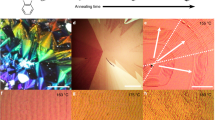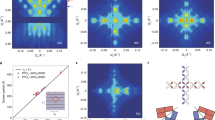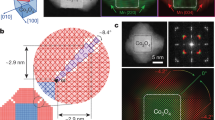Abstract
The physical and chemical properties of low-dimensional structures depend on their size and shape, and can be very different from those of bulk matter. If such structures have at least one dimension small enough that quantum-mechanical effects prevail, their behaviour can be particularly interesting. In this way, for example, magnetic nanostructures can be made from materials that are non-magnetic in bulk1, catalytic activity can emerge from traditionally inert elements such as gold2, and electronic behaviour useful for device technology can be developed3,4. The controlled fabrication of ordered metal and semiconductor nanostructures at surfaces remains, however, a difficult challenge. Here we describe the fabrication of highly ordered, two-dimensional nanostructure arrays through nucleation of deposited metal atoms on substrates with periodic patterns defined by dislocations that form to relieve strain. The strain-relief patterns are created spontaneously when a monolayer or two of one material is deposited on a substrate with a different lattice constant. Dislocations often repel adsorbed atoms diffusing over the surface, and so they can serve as templates for the confined nucleation of nanostructures from adatoms. We use this technique to prepare ordered arrays of silver and iron nanostructures on metal substrates.
This is a preview of subscription content, access via your institution
Access options
Subscribe to this journal
Receive 51 print issues and online access
$199.00 per year
only $3.90 per issue
Buy this article
- Purchase on Springer Link
- Instant access to full article PDF
Prices may be subject to local taxes which are calculated during checkout




Similar content being viewed by others
References
Wildberger, K., Stepanyuk, V. S., Lang, P., Zeller, R. & Dederichs, P. H. Magnetic nanostructures: 4d clusters on Ag(001). Phys. Rev. Lett. 75, 509–512 (1995).
Haruta, M. Size- and support-dependency in the catalysis of gold. Catal. Today 36, 153–166 (1997).
Orlov, A. O., Amlani, I., Bernstein, G. H., Lent, C. S. & Snider, G. L. Realization of a functional cell for quantum-dot cellular automata. Science 277, 928–930 (1997).
Eberl, K. Quantum-dot lasers. Phys. World 10(9), 45–50 (1997).
Eigler, D. M. & Schweizer, E. K. Positioning single atoms with a scanning tunnelling microscope. Nature 344, 524–526 (1990).
Kent, A. D., Molnar, S. v., Gider, S. & Awschalom, D. D. Properties and measurement of scanning tunneling microscope fabricated ferromagnetic particle arrays. J. Appl. Phys. 76, 6656–6660 (1994).
Röder, H., Hahn, E., Brune, H., Bucher, J. P. & Kern, K. Building one- and two-dimensional nanostructures by diffusion-controlled aggregation at surfaces. Nature 366, 141–143 (1993).
Leonard, D., Krishnamurthy, M., Reaves, C. M., Denbaars, S. P. & Petroff, P. M. Direct formation of quantum-sized dots from uniform coherent islands of InGaAs on GaAs-surfaces. Appl. Phys. Lett. 63, 3203–3205 (1993).
Nötzel, R., Tommyo, J. & Tamamura, T. Self-organized growth of strained InGaAs quantum disks. Nature 369, 131–133 (1994).
Moison, J. M. et al. Self-organized growth of regular nanometer-scale InAs dots on GaAs. Appl. Phys. Lett. 64, 196–198 (1994).
Bromann, K. et al. Controlled deposition of size-selected Ag nanoclusters. Science 274, 956–958 (1996).
Tersoff, J., Teichert, C. & Lagally, M. G. Self-organization in growth of quantum dot superlattices. Phys. Rev. Lett. 76, 1675–1678 (1996).
Chambliss, D. D., Wilson, R. J. & Chiang, S. Nucleation of ordered Ni island arrays on Au(111) by surface-lattice dislocations. Phys. Rev. Lett. 66, 1721–1724 (1991).
Meyer, J. A., Baikie, J. D., Kopatzki, E. & Behm, R. J. Preferential island nucleation at the elbows of the Au(111) herringbone reconstruction through place exchange. Surf. Sci. 365, L647–L651 (1996).
Shiryaev, S. Y., Jensen, F., Hansen, J. L., Petersen, J. W. & Larsen, A. N. Nanoscale structuring by misfit dislocations in Si1−xGex/Si epitaxial systems. Phys. Rev. Lett. 78, 503–506 (1997).
Brune, H. et al. The effect of strain on surface diffusion and nucleation. Phys. Rev. B 52, R14380–R14383 (1995).
Brune, H., Röder, H., Boragno, C. & Kern, K. Strain relief at hexagonal close packed interfaces. Phys. Rev. B 49, 2997–3000 (1994).
Ratsch, C., Seitsonen, A. P. & Scheffler, M. Strain-dependence of surface diffusion: Ag on Ag(111) and Pt(111). Phys. Rev. B 55, 6750–6753 (1997).
Fafard, S., Leon, R., Leonard, D., Marz, J. L. & Petroff, P. M. Phonons and radiative recombination in self-assembled quantum dots. Phys. Rev. B 52, 5752–5755 (1995).
Brune, H. Kinetics of nucleation and aggregation in metal epitaxy. Surf. Sci. Rep. 31, 121–126 (1998).
Horn-von-Hoegen, M., Falou, A. A., Pietsch, H., Müller, B. H. & Henzler, M. Formation of the interfacial dislocation network in surfactant-mediated growth of Ge on Si(111) by SPALEED Part I. Surf. Sci. 298, 29–42 (1993).
Wiederholt, T., Brune, H., Wintterlin, J., Behm, R. J. & Ertl, G. Formation of two-dimensional sulfide phases on Al(111): an STM study. Surf. Sci. 324, 91–105 (1994).
Besenbacher, F., Nielsen, L. P. & Sprunger, P. T. in Growth and Properties of Ultrathin Epitaxial Layers (eds King, D. A.& Woodruff, D. P.) 207–257 (Elsevier, Amsterdam, (1997)).
Böhringer, M., Jiang, Q., Berndt, R., Schneider, W. D. & Zegenhagen, J. Discommensurations, epitaxial growth and island formation in Cu/Ge(111). Surf. Sci. 367, 245–260 (1996).
Acknowledgements
We thank J. Jacobsen, K. Jacobsen and J. Nørskov for providing us with the kinetic Monte Carlo computer code that we adopted for nucleation on a superlattice.
Author information
Authors and Affiliations
Rights and permissions
About this article
Cite this article
Brune, H., Giovannini, M., Bromann, K. et al. Self-organized growth of nanostructure arrays on strain-relief patterns. Nature 394, 451–453 (1998). https://doi.org/10.1038/28804
Received:
Accepted:
Issue Date:
DOI: https://doi.org/10.1038/28804
This article is cited by
-
Dislocation interactions during plastic relaxation of epitaxial colloidal crystals
Nature Communications (2023)
-
One-dimensional titanate nanotube materials: heterogeneous solid catalysts for sustainable synthesis of biofuel precursors/value-added chemicals—a review
Journal of Materials Science (2021)
-
Real-Time Characterization Using in situ RHEED Transmission Mode and TEM for Investigation of the Growth Behaviour of Nanomaterials
Scientific Reports (2018)
-
Template Assisted Nucleation of Cobalt and Gold Nano-clusters on an Ultrathin Iron Oxide Film
Topics in Catalysis (2018)
-
Strain-induced growth instability and nanoscale surface patterning in perovskite thin films
Scientific Reports (2016)
Comments
By submitting a comment you agree to abide by our Terms and Community Guidelines. If you find something abusive or that does not comply with our terms or guidelines please flag it as inappropriate.



